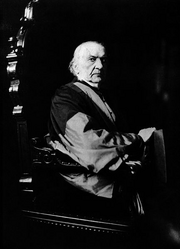The Race for Asia was the European and North American invasion, attack, occupation, and annexation of Asian territory that took place from 1839 to 1914, which was the beginning of World War I.
Great Britain[]

William Ewart Gladstone, the Prime Minister of Great Britain who entered the nation into the race
Following the establishment of the Republic of Great Britain in 1850, many set to work on improving the nation. One step was to get its colonial empire back. Early British colonization attempts failed, and many though the "Sun will never rise on the British Empire". However, in 1880, the election of William Ewart Gladston as president changed all of this. Gladston planned on returning the Republic back to its glory. He started very quickly. The British first traveled to the Maldives, and British control was re-established. The British then moved into Ceylon. A war erupted, known as the Ceylon War. The war, lasting, a year, allowed the British to control Ceylon.
Russia[]

Alexander III, the Tsar of Russia during its expansion into Central Asia.
Because Britain was defeated by France in 1807 by the French, the OTL Great Game never happened. Without Britain, the Russian Empire under Tsar Alexander III expanded in Central Asia. The nation of Sikhia, which was founded by retreating British colonists, looked at this with concern. They were afraid that Russia would soon invade India. To stop this the Sikh-Russian War happened in 1856. The war, which ended in 1858, resulted in a Sikh Pyrrhic victory. Sikhia survived but the nation was destroyed. Russia's march into Central Asia was stopped.
Afghanistan[]
Tsar Alexander III tried to make Afghanistan, which Russia won complete control over in the 1840s, a model to show other countries to what would happen if they are conquered. Alexander III made himself Emperor of Afghanistan, and installed Khan Bahadur Raja Jahandad Khan as the viceroy of the nation. Kabul was made the nations capital, and it was quickly improved on. Roads were built or improved on, factories became up and running, and harbors along the Kabul River were improved. Manufacturing skyrocketed, and machinery was built to improve agriculture. The economy boomed, and many people moved from rural areas to large, crowded cities.
Iran[]

Map of Greater Persia in 1814.
Following their successful conquering of Afghanistan, Russia moved its attention from Central Asia to Persia. However, this would conflict with the interests of Abdulalziz I, the Sultan of the Ottoman Empire. Following the overthrow of Mamluk regime in Iraq and the subsequent Ottoman invasion, Persia was open to the Ottomans. Sultan Abdulmecid I planned to do this, but was preoccupied with the Crimean War, which the Ottomans lost. Now with the consequences of the war behind, the Ottoman Empire could invade. The result was the Persian War, which Russia won. This allowed Russia to invade Persia, and severely weakened the Ottoman Empire.
United States[]
Because Britain was defeated in the British Invasion of Canada and Mexico handed over its territory in the west, American expanded faster. It now set its eyes on the Pacifc and Asia. In 1853, the United States sent Commodore Matthew C. Perry to Japan. Once Perry got there and earned the trust of the Japanese, negotiations began about trade. A year later the treaty was signed, opening Japan up to merchants of the United States.
Japan[]

Flag of the new Empire of Japan
Following the signing of the treaty, the capital city of Edo was opened to western merchants. With the introdution of western technology and ideas, the old Tokugawa shogunate, which ruled Japan from 1600, was beginning to decay. On January 3, 1868, the Meiji period began with the formation of a new government, and the shogunate was overthrown. Imperial rule was restored, and Edo was renamed Tokyo. The Empire of Japan was formed. Rapid industrialization began, and the military and navy was modernized. In 1871, the first railroad was opened.
The Pacific[]

On the cover of the magazine Puck after the First Pacific War, Columbia wears a warship bearing the words "World Power" as an Easter Bonnet and the word "Expansion" on the smoke from its stack.
The United States continued their expansion into the numerous islands in the Pacific. Following the revolution in the Iberian Union, many of the nation's overseas colonies in the Pacific had claimed independence. The United States quickly filled the Union's place. Ships of the US Navy landed in the many islands, and the first ones were Guam and the Philippines. New revolutionary leader, Bayani Reynante, signed a treaty with the United States, allowing them to dock ships in the harbors of Manila. Guam similarly opened up their ports as well.
In 1886, during the height of the First Pacific War, Hawaii was a strategic location for both sides of the war. Entrance into the war split the Hawaiians, and the Hawaiian Revolution began. The revolution, which was one by pro-war, entered negotiations with the United States. In 1896, the Republic of Hawaii became Hawaiian Territory of the United States.
